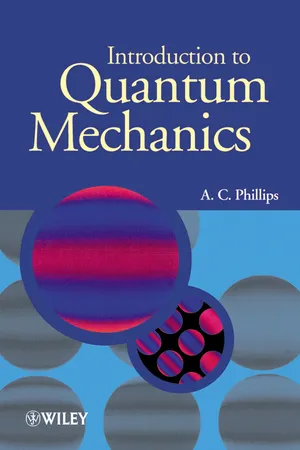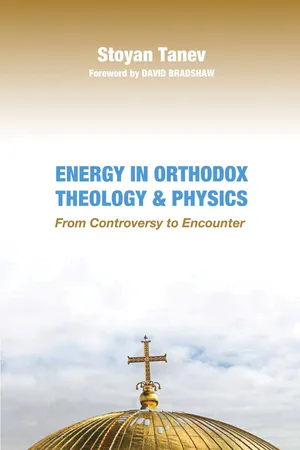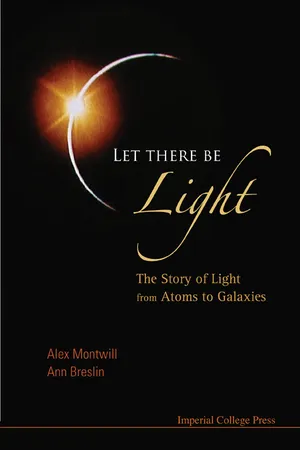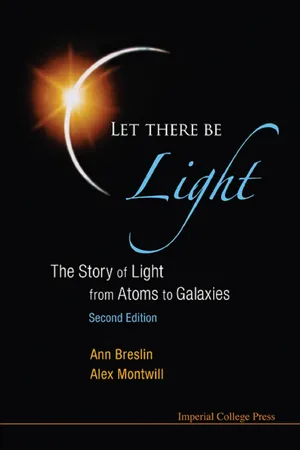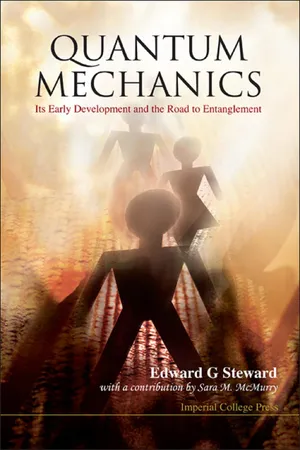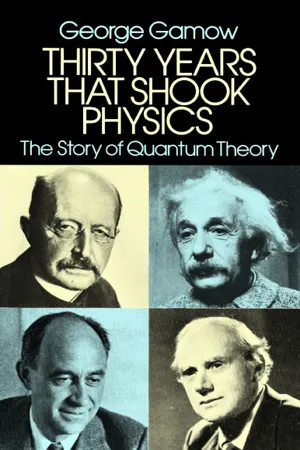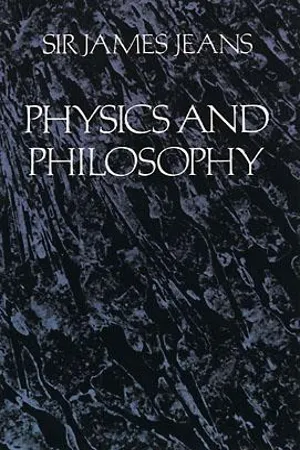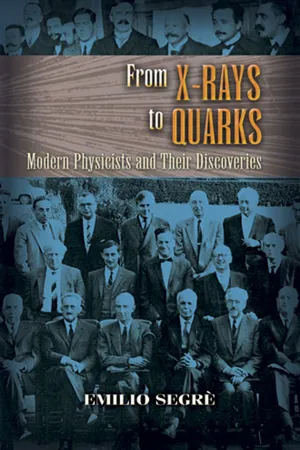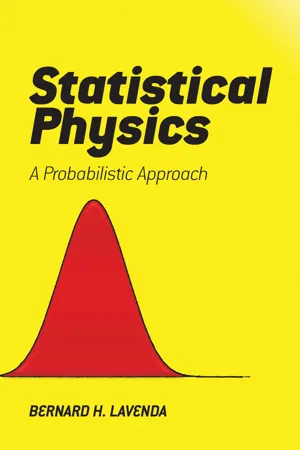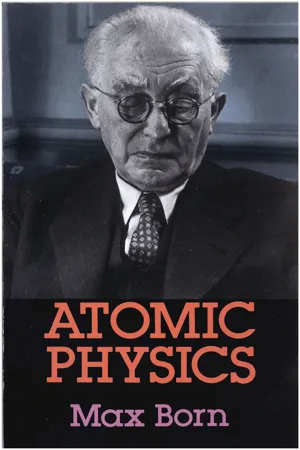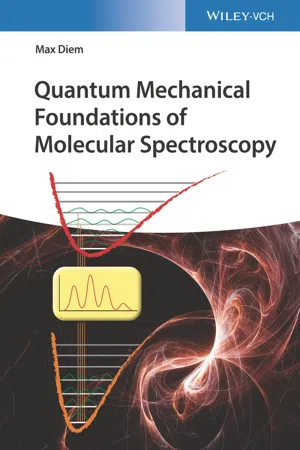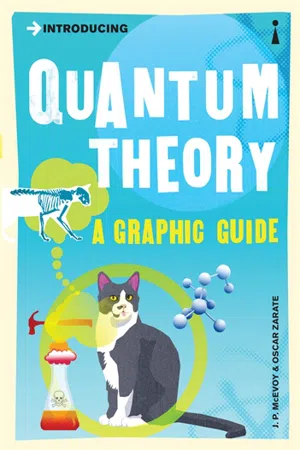Physics
Planck Postulate
The Planck postulate, proposed by Max Planck in 1900, states that energy is quantized, meaning it exists in discrete, indivisible units called quanta. This concept revolutionized the understanding of energy and laid the foundation for quantum theory. Planck's postulate was instrumental in explaining phenomena such as blackbody radiation and the photoelectric effect, and it ultimately led to the development of quantum mechanics.
Written by Perlego with AI-assistance
Related key terms
Related key terms
1 of 4
Related key terms
1 of 3
12 Key excerpts on "Planck Postulate"
- eBook - ePub
- A. C. Phillips(Author)
- 2013(Publication Date)
- Wiley(Publisher)
1Planck’s constant in action
Classical physics is dominated by two fundamental concepts. The first is the concept of a particle, a discrete entity with definite position and momentum which moves in accordance with Newton’s laws of motion. The second is the concept of an electromagnetic wave, an extended physical entity with a presence at every point in space that is provided by electric and magnetic fields which change in accordance with Maxwell’s laws of electromagnetism. The classical world picture is neat and tidy: the laws of particle motion account for the material world around us and the laws of electromagnetic fields account for the light waves which illuminate this world.This classical picture began to crumble in 1900 when Max Planck published a theory of black-body radiation; i.e. a theory of thermal radiation in equilibrium with a perfectly absorbing body. Planck provided an explanation of the observed properties of black-body radiation by assuming that atoms emit and absorb discrete quanta of radiation with energy = hv , where v is the frequency of the radiation and h is a fundamental constant of nature with valueThis constant is now called Planck’s constant.In this chapter we shall see that Planck’s constant has a strange role of linking wave-like and particle-like properties. In so doing it reveals that physics cannot be based on two distinct, unrelated concepts, the concept of a particle and the concept of a wave. These classical concepts, it seems, are at best approximate descriptions of reality.1.1 PHOTONS
Photons are particle-like quanta of electromagnetic radiation. They travel at the speed of light c with momentum p and energy given by(1.1)where λ is the wavelength of the electromagnetic radiation. In comparison with macroscopic standards, the momentum and energy of a photon are tiny. For example, the momentum and energy of a visible photon with wavelength λ = 663 nm are - eBook - ePub
Energy in Orthodox Theology and Physics
From Controversy to Encounter
- Tanev(Author)
- 2017(Publication Date)
- Pickwick Publications(Publisher)
1900 it allowed the German physicist Max Planck to create an adequate mathematical model of a troubling problem—so called black-body radiation, i.e., the radiation that is emitted by a specific type of heated bodies. Planck worked with careful experimental measurements of the actual energy distribution trying to develop a correct theoretical model to describe it. Eventually, he found out that he could do that only if he assumed that the emitted energy could change only in jumps, from one energy level to the next. This assumption in Planck’s model violated the usual way of thinking about energy—as a quantity that could vary smoothly, increasing or decreasing gradually, rather than being confined to stepwise change. Some people consider Planck’s assumption as a “desperate” move, but the only one possible, enabling him to fit the empirical data on black-body radiation. Planck called these discrete energy changes “quanta” of energy. He assumed that their necessity in the theory would soon be explained, and that the explanation would not require energy itself to exist only in bundles of specific sizes. He, however, was not able to come up with such an explanation himself.The universal meaning of the energy quantum conceptVery soon other physicists began to see the more universal meaning in Planck’s idea. In a paper from 1905 dedicated to the photoelectric effect, Albert Einstein argued that light itself should not be understood simply as wave motion but should also be understood in terms of light quanta—massless packets of energy that were later to be called “photons.” The energy of a single photon E was found to be proportional to the light’s frequency ν by means of a universal constant h : E = hν . The constant h was first derived by Planck and, therefore, known as Planck’s constant or the “quantum of action.” Soon after the emergence of the photon, the idea of the quantum nature of energy was extensively infiltrated into microphysics.In 1913 the Danish physicist Niels Bohr opened up a critically important new arena for the use of the concept—atomic spectra. It was the exploration of this arena that led to the emergence of quantum physics. Bohr adopted Planck’s quantum to study the internal structure of atoms in a way that was “in obvious contrast to the ordinary ideas of electrodynamics but appears to be necessary in order to account for experimental facts.”322 - eBook - ePub
Let There Be Light
The Story of Light from Atoms to Galaxies
- Alex Montwill, Ann Breslin(Authors)
- 2008(Publication Date)
- ICP(Publisher)
hf.Up to then, an inherent understanding in natural philosophy was that there are no restrictions on the possible values of physical entities. The suggestion that Nature is not continuous was so reactionary that Planck was afraid to publish his hypothesis, and it was in fact not generally accepted until the successful work of Niels Bohr in 1913. Physicists were reluctant to abandon long-established beliefs, with some notable exceptions, such as Albert Einstein, who in 1905 had developed the concept of quantisation even further in his theory of the photoelectric effect.To follow this chapter in detail, some knowledge of basic mechanics and thermodynamics is helpful, but the reader should get a good feeling for the concepts by skimming through the more detailed parts of the discussion, particularly in Section 11.2. When you come to Sections 11.5.1–11.5.4, again skim through the mathematical discussion. If you are comfortable with the mathematics, however, you should enjoy following Planck's footsteps to one of the most fundamental discoveries in the history of physics….11.1 Emission of energy by radiation11.1.1 How does matter emit electromagnetic energy?Matter consists of atoms and molecules containing protons and electrons, which respectively have positive and negative charge. There is always electrical activity even in an electrically neutral piece of matter, because of atomic oscillators whose motion becomes more rapid with increasing temperature. As predicted by Maxwell, and verified by Hertz in 1888, oscillating charges emit electromagnetic waves and in the process lose energy and slow down. That is one way in which a hot surface may cool down by radiating light into the space around it. Eventually, thermal equilibrium is established when the average energy emitted per second is balanced by the radiation absorbed. - eBook - ePub
Let There Be Light
The Story of Light from Atoms to Galaxies
- Ann Breslin, Alex Montwill(Authors)
- 2013(Publication Date)
- ICP(Publisher)
hf.Up to then, an inherent understanding in natural philosophy was that there are no restrictions on the possible values of physical entities. The suggestion that nature is not continuous was so revolutionary that Planck was afraid to publish his hypothesis, which was not generally accepted until 1913, when Niels Bohr used quantum theory in his radical model of atomic structure. Physicists were reluctant to abandon long-established beliefs, with some notable exceptions, such as Albert Einstein, who in 1905 had developed the concept of quantization even further in his theory of the photoelectric effect.*To follow this chapter in detail, some knowledge of basic mechanics and thermodynamics is helpful but, even without it, you should enjoy following Planck’s footsteps to one of the most fundamental discoveries in the history of physics.11.1 Emission of energy by radiation How does matter emit electromagnetic energy?Matter consists of atoms and molecules containing positively charged protons and negatively charged electrons. There is always electrical activity, even in an electrically neutral piece of matter, because of atomic oscillators whose motion becomes more rapid with increasing temperature. As predicted by Maxwell, and verified by Hertz in 1888, oscillating charges emit electromagnetic waves and in the process lose energy and slow down. The hot surface cools down by radiating light into the space around it. Eventually, thermal equilibrium is established when the average energy emitted per second is balanced by the radiation absorbed. - eBook - ePub
Quantum Mechanics
Its Early Development and the Road to Entanglement
- Edward G Steward(Author)
- 2008(Publication Date)
- ICP(Publisher)
T) in order to obtain his famous radiation formula (Eqn. 3.34) that agreed with all the experimental data:This step that Planck had taken was of course quite alien to Classical Theory. In contrast, Einstein, in his 1905 paper, arrived at the concept of the light quantum (with which he then very successfully explained the photoelectric effect) solely from thermodynamic and statistical considerations (§4.3 ) without it being invoked as it was in Planck’s theory of black-body radiation.To reconcile the two obviously successful quantisation concepts, Einstein proposed that Planck’s initial classically-derived equation (Eqn. 4.1) must also be accepted as a valid quantum theory, though its foundation was a mystery when quantum effects are important. This was a major decision and detailed examination of Planck’s derivation of the equation led him to conclude that “We must consider the (following) theorem to be the basis of Planck’s radiation theory: the energy of a [Planck oscillator] can take on only those values that are integral multiples of hν; in emission and absorption the energy of a [Planck oscillator] changes by jumps which are multiples of hν” (Pais — see Bibliography). We had E = nhν, where E = hν became known as Einstein’s Energy Equation.Einstein’s acceptance of Planck’s initial equation was a major step forward because it was no longer a hindrance to his thinking. In contrast, Planck’s acceptance of Einstein’s work, in which light was seen to be transmitted in quanta, was not so immediate because Planck still assumed that “what happens in the vacuum is rigorously described by Maxwell’s equations”.1907
A quantum theory of specific heats was published which solved the anomaly in the classical treatment (§4.5 ). It was an early demonstration of the wider applicability of quantum theory that saw the birth of solid state quantum theory. In this paper, Einstein used his work on fluctuations (§4.4 - eBook - ePub
Thirty Years that Shook Physics
The Story of Quantum Theory
- George Gamow(Author)
- 2012(Publication Date)
- Dover Publications(Publisher)
Fig. 5. If, according to Planck’s hypothesis, the energy corresponding to each frequency v must be an integer of the quantity hv, the situation is quite different from that shown in the previous diagram. For example, for v = 4 there are eight possible vibration states, whereas for v = 8 there are only four. This restriction reduces the number of possible vibrations at high frequencies and cancels Jeans’ paradox.It has been said that there are “lies, white lies, and statistics,” but in the case of Planck’s calculations the statistics turned out to be well-nigh true. He had obtained for energy distribution in thermal radiation spectrum a theoretical formula that stood in perfect agreement with the observation shown in Fig. 2 .While the Rayleigh-Jeans formula shoots sky high, demanding an infinite amount of total energy, Planck’s formula comes down at high frequencies and its shape stands in perfect agreement with the observed curves. Planck’s assumption that the energy content of a radiation quantum is proportional to the frequency can be written as:where v (the Greek letter nu) is the frequency and h is a universal constant known as Planck’s Constant, or the quantum constant. In order to make Planck’s theoretical curves agree with the observed ones, one has to ascribe to h a certain numerical value, which is found to be 6.77 × 10−27 in the centimeter-gram-second unit system.¶The numerical smallness of that value makes quantum theory of no importance for the large-scale phenomena which we encounter in everyday life, and it emerges only in the study of the processes occurring on the atomic scale.LIGHT QUANTA AND THE PHOTOELECTRIC EFFECTHaving let the spirit of quantum out of the bottle, Max Planck was himself scared to death of it and preferred to believe the packages of energy arise not from the properties of the light waves themselves but rather from the internal properties of atoms which can emit and absorb radiation only in certain discrete quantities. Radiation is like butter, which can be bought or returned to the grocery store only in quarter-pound packages, although the butter as such can exist in any desired amount (not less, though, than one molecule!). Only five years after the original Planck proposal, the light quantum was established as a physical entity existing independently of the mechanism of its emission or absorption by atoms. This step was taken by Albert Einstein in an article published in 1905, the year of his first article on the Theory of Relativity. Einstein indicated that the existence of light quanta rushing freely through space represents a necessary condition for explaining empirical laws of the photoelectric effect; that is, the emission of electrons from the metallic surfaces irradiated by violet or ultraviolet rays. - eBook - ePub
- Sir James H. Jeans(Author)
- 2012(Publication Date)
- Dover Publications(Publisher)
h is found to be a universal constant of nature. It is generally known as Planck’s constant, and incidentally has dominated atomic physics since its discovery. We have already seen (p. 125) that some such constant was much needed to give a definite size to the atom; here it was.The Photo-electric Effect
Not only was Planck’s theory immediately successful with those particular problems of radiation for which it had been especially designed, but further confirmation of its truth was soon forthcoming from entirely different quarters. Much of the evidence had been known for some time, but it needed an Einstein to point out its significance (1905).The evidence in its simplest form was provided by a phenomenon known as the ‘Photo-electric Effect’. When ultra-violet radiation (p. 53) falls on a metal surface, a stream of electrons is found to be ejected from the metal. If radiation is pictured as waves, there is no difficulty in seeing in a general way why this should be; the incidence of the radiation may well shake the electrons about in the atoms of the metal, and under very intense radiation they might break loose altogether—like boats breaking loose from their moorings in a stormy sea. Yet if this were the true explanation, weakening the radiation ought to result in the electrons being ejected with less energy, or perhaps not coming off at all. Actually a weakening of the radiation leaves the energy of each electron unimpaired, although reducing the number of electrons shot off. This number is proportional to the intensity of the radiation, so that even the feeblest stream of radiation produces a minute trickle of electrons in which each individual moves just as vigorously as in the bigger flow produced by more intense radiation; it is as though the radiation was a hail of projectiles, hitting some electrons out of their atoms, but leaving the rest untouched. - eBook - ePub
From X-rays to Quarks
Modern Physicists and Their Discoveries
- Emilio Segrè(Author)
- 2012(Publication Date)
- Dover Publications(Publisher)
Planck adds a poignant note: “It gave me particular satisfaction, in compensation for the many disappointments I had encountered, to learn from Ludwig Boltzmann of his interest and complete agreement in my new line of reasoning.” However, although Boltzmann agreed, Planck’s reasoning was subject to numerous serious objections. Such fundamental and revolutionary ideas were not easily assimilated. In spite of the various flaws mentioned above, the work was not ignored, but it was not at the center of attention. There were many spectacular discoveries at this time, and Planck himself was so diffident of the methods used that he spent years trying to explain his results in a less revolutionary way.Figure 4.5 Other excerpts from the same paper by Planck. Above, equation (12) contains the formula for the distribution of energy in the blackbody radiation as a function of frequency v and temperature θ . The constant h appears in it as well as the velocity of light c and Boltzmann’s constant k. Below, the numerical values of h and k in 1900 [formulae (15) and (16)]. Using these numbers, one can obtain the numerical values of the charge of the electron, of Avogadro’s number, and of other universal constants in physics. These values stood unsurpassed for many years.In 1931 the American physicist R. W. Wood asked Planck how he had invented something as incredible as the quantum theory. Planck answered, “It was an act of desperation. For six years I had struggled with the blackbody theory. I knew the problem was fundamental and I knew the answer. I had to find a theoretical explanation at any cost, except for the inviolability of the two laws of thermodynamics” [Armin Hermann, The Genesis of Quantum Theory (MIT Press, 1971), p. 23]. At the end of his life he commented further:However, even at the beginning Planck was aware of the importance of his discovery. It is reported that, on a walk, Planck told his son that he had found something worthy of Newton.My vain attempts to somehow reconcile the elementary quantum with classical theory continued for many years, and cost me great effort,. Many of my colleagues saw almost a tragedy in this, but I saw it differently because the profound clarification of my thoughts I derived from this work had great value for me. Now I know for certain that the quantum of action has a much more fundamental significance than I originally suspected.As time passed, Planck became one of the most highly regarded German physicists. He was secretary of the Prussian Academy of Sciences and one of the most influential representatives of German science. Einstein, who did not sympathize with the German establishment, nevertheless had a deep respect for his colleague, even if they differed in political and scientific outlook. Their friendship was further reinforced by their common love for music, which they played together. Besides his scientific eminence, Planck’s character inspired universal respect. A firm conservative, he found himself compelled by the strength of factual evidence and logical rigor to promote one of the greatest revolutions in natural philosophy. - eBook - ePub
Statistical Physics
A Probabilistic Approach
- Bernard H. Lavenda(Author)
- 2016(Publication Date)
- Dover Publications(Publisher)
Chapter 2Black Radiation: A Case History2.1Historical PerspectiveIt has often been said that Max Planck hypothesized the existence of discrete quanta so as to “discourage’ radiant energy from flowing into the high frequency part of the spectrum. Yet, Planck saw no compelling reason for a real quantum theory of radiation, and in the years that followed his radical step he steadily retreated from such an abrupt departure from classical physics. Planck’s original goal was to justify his empirically proposed formula for black radiation and paid little attention to the radical idea that the energy of his oscillators, which were supposedly buried in the walls of a black body, were always a discrete multiple of an energy unit. In this sense, Planck was a reluctant revolutionary, and little of his original derivation and motivation can be found in texts on statistical mechanics. All that remains is the final result with some artifice to justify it. Yet, his thermodynamic thinking is at the basis of the different physical forms of statistics so that it would indeed be a shame to neglect it. Nothing is better than a lucid historical account of what drove Planck to attack the problem of black radiation and how the role of entropy played a fundamental role in justifying his empirical formula. To understand Planck’s line of reasoning, we have to begin at the beginning.The thermodynamic treatment of electromagnetic radiation goes back to Gustav Robert Kirchhoff (1860), Josef Stefan (1879), Ludwig Boltzmann (1884), and Wilhelm Wien (1896) which finally culminated in the birth of the quantum theory through Planck’s formula for black radiation. Assuming an equilibrium between a black and a nonblack body at the same temperature, Kirchhoff related the rate of energy emitted by the nonblack body to its absorptivity. Radiation emitted by black bodies is called “thermal” radiation because both its intensity and spectrum are functions of the emitter’s temperature only. In contrast, the spectrum of “nonthermal” radiation, noted for its high intensity, is characterized by an energy gap in the distribution of states as a function of energy. A perfect black body consists of a container with perfectly reflecting walls that are maintained at a constant temperature into which small bodies are introduced that can absorb and re-emit radiation at all possible wavelengths. This allows for energy exchange among the different modes of vibration of the electromagnetic field. Ordinary black bodies, such as charcoal, possess this property at least in the visible part of the spectrum; “idealistic” black bodies behave in the same way at all possible frequencies. Nonthermal radiation is far too large for the temperature of the body which emits it to be in thermal equilibrium. Some examples of this luminescent form of radiation are glow discharges, luminescent diodes, and lasers. - eBook - ePub
- Max Born(Author)
- 2013(Publication Date)
- Dover Publications(Publisher)
CHAPTER VII Quantum Statistics 1. Heat Radiation and Planck’s Law. We have already mentioned several times that the quantum theory is of statistical origin; it was devised by Planck when he was endeavouring to deduce the law of heat radiation (1900). If, contrary to the order of historical development, ww have discussed the quantum theory of the atom before quantum statistics, we have our reasons. In the first place, the failure of the classical theory displays itself in atomic mechanics—for instance, in the explanation of line spectra or the diffraction of electrons—even more immediately than in the attempts to fit the law of radiation into the frame of classical physics. In the second place, it is an advantage to understand the mechanism of the individual particles and the elementary processes before proceeding to set up a system of statistics based upon the quantum idea. In this chapter we shall supply what is lacking, and begin with the deduction of the law of heat radiation, following Planck’s method. We think of an enclosure, say a box, whose walls are heated by some contrivance to a definite temperature T. The walls of the enclosure send out energy to each other in the form of heat radiation, so that within the enclosure there is a radiation field. We characterize this electromagnetic field by specifying the energy density u, which in the case of equilibrium is the same for every internal point; if we split up the radiation into its spectral components, we denote by u v dv the energy density of all radiation components whose frequency falls in the interval between v and v + dv. Thus the function u v extends over all frequencies from 0 to ∞; it represents a continuous spectrum. Up till now we have been occupied with line spectra, which are emitted by individual atoms in rarefied gases. But even molecules, consisting of only a limited number of atoms, do not send out isolated lines as single atoms do, but narrow “bands”, often not resoluble - Max Diem(Author)
- 2021(Publication Date)
- Wiley-VCH(Publisher)
x, t). This postulate contains the transition from a deterministic to probabilistic description of a quantum mechanical system. The wavefunctions must be mathematically well behaved, that is, they must be single‐valued, continuous, having a continuous first derivative, and integratable (so they can be normalized).Postulate 2: The classical linear momentum expression, p = mv, is substituted in quantum mechanics by the differential operator , defined by(2.2)operating (or being applied to) the wavefunction Ψ(x, t). In Eq. (2.2) , i is the imaginary unit, defined by Equation (2.2) often is considered the central postulate of QM.The form of Eq. (2.2) can be made plausible from equations of classical wave mechanics, de Broglie's equation (Eq. [1.10] ) and Planck's equation (Eq. [1.7] ), but cannot be derived axiomatically. It was the genius of E. Schrödinger to realize that the substitution described in Eq. (2.2) yields differential equations that had long been known and had solutions that agreed with experiments. In the Schrödinger equations to be discussed explicitly in the next chapters (for the H atom, the vibrations and rotations of molecules, and molecular electronic energies), the classical kinetic energy T given by(2.3)is, therefore, substituted by(2.4)which is, of course, obtained by inserting Eq. (2.2) into Eq. (2.3) . The total energy of a system is given as the sum of the potential energy V and the kinetic energy T:(2.5)Postulate 3: All experimental results are referred to as observables that must be real (not imaginary or complex). An observable is associated with (or is the “eigenvalue” of) a quantum mechanical operator . This can be written as(2.6)where a are the eigenvalues and ϕ the corresponding eigenfunctions. The terms “operator,” “eigenvalues,” and “eigenfunctions” are terminology from linear algebra and will be further explained in Section 2.3- eBook - ePub
Graphic Guides
A Graphic Guide
- J.P. McEvoy, Oscar Zarate(Authors)
- 2014(Publication Date)
- Icon Books(Publisher)
CONTRARY TO ALL MY EXPECTATIONS, I AM COMPELLED TO ASSERT ITS UNAMBIGUOUS EXPERIMENTAL VERIFICATION IN SPITE OF ITS UNREASONABLENESS.THE HYPOTHESIS WAS MADE SOLELY BECAUSE IT FURNISHED A READY EXPLANATION OF THE FACT THAT THE ENERGY OF AN EJECTED ELECTRON IS INDEPENDENT OF THE INTENSITY OF THE LIGHT . . . BUT DEPENDS ON THE FREQUENCY. I UNDERSTAND EVEN EINSTEIN HIMSELF NO LONGER ACCEPTS IT.Such sentiments were typical of physicists in the second decade of the 20th century. Clearly, the prediction of quantized radiation was not a great triumph for Planck and Einstein.IN FACT, DURING THIS PERIOD OUR WORK WAS COMPLETELY IGNORED.In the early 1900s, more sensational discoveries were being made, in radioactivity by Becquerel and the Curies in France, as well as the miraculous X-rays demonstrated by Röntgen in Germany. This attracted the attention of physicists away from the problems of light radiation.Meanwhile, Planck himself rejected not only Einstein’s, but his own revolutionary work on light quanta. However, he was impressed with Einstein’s work in relativity, and wrote to the Prussian Academy in support of his membership. But he felt it necessary to apologise for the photons . . .THOUGH HE MAY SOMETIMES HAVE MISSED THE TARGET IN HIS SPECULATIONS, FOR EXAMPLE IN HIS HYPOTHESIS OF LIGHT QUANTA, THIS CAN’T REALLY BE HELD AGAINST HIM. FOR IT IS NOT POSSIBLE TO INTRODUCE FUNDAMENTALLY NEW IDEAS IN THE MOST EXACT SCIENCES WITHOUT OCCASIONALLY TAKING A RISK.Bright Line Light Spectra
We are now ready for the third experiment which could not be explained by the classical physicists – Bright Line Light Spectra. Remember the list. . .Black-Body Radiation (explained by Planck)The Photoelectric Effect (explained by Einstein)Bright Line Light Spectra (to be explained by Bohr)For 150 years, precise observations of light emission from gases had been accumulating in European physics laboratories. Many believed these held the secrets of the atom. But how to decipher this vast store of information to create order from chaos? That was the challenge. Reports began as far back as 1752 when the Scottish physicist, Thomas Melvill, put containers of different gases over a flame and studied the glowing light emitted.
Index pages curate the most relevant extracts from our library of academic textbooks. They’ve been created using an in-house natural language model (NLM), each adding context and meaning to key research topics.
Explore more topic indexes
Explore more topic indexes
1 of 6
Explore more topic indexes
1 of 4
